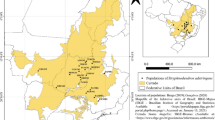Abstract
Incarvillea is a genus with considerable ornamental and medicinal value, yet many of its 16 species are threatened in the wild and two (Incarvillea forrestii and Incarvillea altissima) may be extinct. An extensive field survey of the Chinese species has shown that logging is the greatest threat to woodland margin species, while overgrazing by cattle endangers species from alpine meadows. To aid the setting of conservation priorities, we used phylogenetic weighting of species, based on the molecular phylogeny of both nuclear (nrITS) and chloroplast (trnL-F region) gene regions. We estimated molecular diversity with measures for genetic diversity (GD) and phylogenetic diversity (PD). PD/GD values highlighted the importance of Incarvillea sinensis and two Central Asian species, Incarvillea semiretschenskia and Incarvillea olgae from Kazakstan and Kirghizia, for which little is known. This combination of phylogenetic and complementarity analyses focused on the provinces of Sichuan, Yunnan, and Qinghai, with Yunnan having the only adequately protected areas for that genus.






Similar content being viewed by others
References
Chen ST, Guan KY, Zhou ZK, Fuijiki T (2003) Pollen morphology of the genus Incarvillea (Bignoniaceae). Acta Bot Yunnan 25:457–467
Chen ST, Zhou ZK, Guan KY, Nakata M (2004) Karyomorpholoical study of Incarvillea Juss. (Bignoniaceae) and its implications in distribution and taxonomy. Bot J Linn Soc 144:113–121
Chen ST, Guan KY, Zhou ZK, Olmstead R, Cronk Q (2005) Molecular phylogeny of Incarvillea (Bignoniaceae) based on ITS and trnL-F sequences. Am J Bot 92:625–633
Chen ST, Guan KY, Zhou ZK (2006) A new subgenus of Incarvillea (Bignoniaceae). Ann Bot Fenn 43:288–290
Crozier RH (1992) Genetic diversity and the agony of choice. Biol Conserv 61:11–15
Crozier RH (1997a) Preserving the information content of species: genetic diversity, phylogeny and conservation worth. Annu Rev Ecol Syst 28:243–268
Crozier RH (1997b) A genetic diversity approach to conservation: genetic similarities and differences between species. Proc Assoc Adv Anim Breed Genet 12:624–632
Crozier RH, Kusmierski RM (1994) Genetic distances and the setting of conservation priorities. In: Loeschcke V, Tomiuk J, Jain DK (eds) Conservation Genetics. Birkhauser Verlag, Basel, Switzerland, pp 227–237
Crozier RH, Apagow PM, Pedersen K (1999) Towards complete biodiversity assessment: an evaluation of the subterranean bacterial communities in the Oklo region of the sole surviving natural nuclear reactor. FEMS Microbiol Ecol 28:325–334
Cullen J, Alexander JCM, Brickell CD, Edmondson JR, Green PS, Heywood VH, Jørgensen PM, Jury SL, Knees SG, Maxwell HS, Miller DM, Robson NKB, Walters SM, Yeo PF (2000) Incarvillea. In: The European garden glora (IV). Cambridge University Press, Cambridge, UK, pp 354–356
Faith DP (1992) Conservation evaluation and phylogenetic diversity. Biol Conserv 61:1–10
Faith DP (1994) Phylogenetic diversity: a general framework for the prediction of feature diversity. In: Forey PL, Humphries CJ, Vane-Wright RI (eds) Systematics and Conservation Evaluation. Clarendon, Oxford, UK, pp 251–268
Farris JS, Källersjö M, Kluge AG, Bult C (1994) Testing significance of incongruence. Cladistics 10:315–319
Felsenstein J (1989) PHYLIP: Phylogeny Inference Package (version 3.2). Cladistics 5:164–166
Grey-Wilson C (1994) A survey of Incarvillea in cultivation. New Plantsman 1:36–52
Grey-Wilson C (1998) A new look at the subgenus Pteroscleris. New Plantsman 5:76–98
Grierson AJC (1961) A revision of the genus Incarvillea. Notes Roy Bot Gard Edinburgh 23:303–354
Jiangsu New Medical College (1995) Incarvillea. In: Dictionary of traditional Chinese medicine. Shanghai Science and Technology Press, Shanghai, pp 2343–2357
Justus J, Sarkar S (2002) The principle of complementarity in the design of reserve networks to conserve biodiversity: a preliminary history. J Biosci 27:421–435
Mace GMS, Stuart N (1994) Draft IUCN red list categories, version 2.2. Species 21–22:13–24
Mace GM, Gittleman JL, Purvis A (2003) Preserving the tree of life. Science 300:1707–1709
Magurran AE (2005) Biological diversity. Curr Biol 15:R116–R118
Margules CR, Pressey RL (2000) Systematic conservation planning. Nature 405:243–253
May RM (1992) How many species inhabit the earth? Sci Am 267:42–48
Meyer A (1993) Phylogenetic relationships and evolutionary processes in East African cichlid fishes. Trends Ecol Evol 8:279–284
Mickevich MF, Farris JS (1981) The implications of congruence in Menidia. Syst Zool 30:351–370
Nakamura M, Chi YM, Yan WM, Nakasugi Y, Yoshizawa T, Irino N, Hashimoto F, Kinjo J, Nohara T, Sakurada S (1999) Strong antinociceptive effect of incarvillateine, a novel monoterpene alkaloid from Incarvillea sinensis. J Nat Prod 62:1293–1294
Nakamura M, Kido K, Kinjo J, Nohara T (2000) Antinociceptive substances from Incarvillea delavayi. Phytochemistry 53:253–256
Nakamura M, Chi YM, Yan WM, Yonezawa A, Nakasugi Y, Yoshizawa T, Hashimoto F, Kinjo J, Nohara T, Sakurada S (2001) Structure-antinociceptive activity studies of incarvillateine, a monoterpene alkaloid from Incarvillea sinensis. Planta Med 67:114–117
Nee S, May RM (1997) Extinction and the loss of evolutionary history. Science 278:692–694
Swofford DL (2001) PAUP*: phylogenetic analysis using parsimony (* and other methods), version 4.0 beta 10. Sinauer, Sunderland
Vane-Wright RI, Humphries CJ, Williams PH (1991) What to protect?—Systematics and the agony of choice. Biol Conserv 55:235–254
Wang WT, Pan KY, Zhang ZY, Li ZY (1990) Incarvillea Juss.. In: Flora reipublicae popularis sinicae, vol 69. Science Press, Beijing, pp 34–49
Wilson EO (1992) The Diversity of Life. Harvard University Press, Cambridge
Zhao QS (1988) A new species of Incarvillea (Bignoniaceae) from Sichuan. J Syst Evol 26:78–79
Acknowledgements
This study was jointly funded by the National Natural Science Foundation of China (30770137), the Natural Science Foundation of Yunnan Province (2007C087M), and the West Light Foundation of the Chinese Academy of Sciences.
Author information
Authors and Affiliations
Corresponding author
Rights and permissions
About this article
Cite this article
Chen, S., Gong, J., Guan, K. et al. Biodiversity Conservation of the Genus Incarvillea Juss. (Bignoniaceae) Based on Molecular Diversity and Species Richness Assessment. J. Plant Biol. 53, 387–394 (2010). https://doi.org/10.1007/s12374-010-9127-6
Received:
Revised:
Accepted:
Published:
Issue Date:
DOI: https://doi.org/10.1007/s12374-010-9127-6




